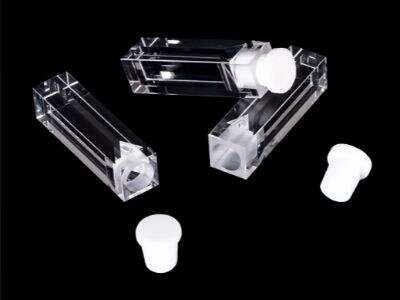สวัสดี นักอ่านหนุ่มสาว! ในตอนนี้ เราจะมาเรียนรู้เกี่ยวกับเครื่องมือทางวิทยาศาสตร์ที่สำคัญซึ่งมีชื่อว่า quartz cuvette เครื่องมือนี้มีความสำคัญสำหรับการทดลองประเภทหนึ่งที่เรียกว่า fluorescence spectroscopy ดังนั้นเรามาดูกันเถอะว่า Jinke Optical หลอดทดลองควอตซ์ ทำงานอย่างไรและทำไมจึงมีประโยชน์มากในทดลองเกี่ยวกับแสงเหล่านี้
คุณรู้หรือไม่ว่านักวิทยาศาสตร์มีเครื่องมือที่เจ๋งมากหลายอย่างเพื่อศึกษาโลกรอบตัวเรา? การทดลองหนึ่งที่สำคัญเรียกว่าสเปกโตรสโคปี การสังเกตลายเซ็นของแสงเมื่อปฏิสัมพันธ์กับวัสดุต่าง ๆ ซึ่งก็คือสเปกโตรสโคปี ช่วยให้นักวิทยาศาสตร์เข้าใจถึงลักษณะของวัสดุเหล่านั้นได้ สเปกโตรสโคปีแบบฟลูออเรสเซนซ์เป็นประเภทที่พบบ่อยที่สุด ซึ่งเกี่ยวข้องกับการดูว่าโมเลกุลเล็ก ๆ ตอบสนองอย่างไรในสภาพแวดล้อมต่าง ๆ มันน่าตื่นเต้นเพราะสามารถเปิดเผยข้อมูลสำคัญเกี่ยวกับการทำงานของโลก!
เพื่อให้ได้ผลลัพธ์ที่ดีที่สุดจาก thí nghiệmฟลูออเรสเซนซ์ จำเป็นต้องใช้หลอดทดลองที่เหมาะสม Jinke Optical หลอดทดลองควอตซ์ เป็นภาชนะขนาดเล็กที่นักวิทยาศาสตร์ใช้ในการเก็บตัวอย่างเพื่อการทดสอบ ผลลัพธ์ของการทดลองอาจได้รับผลกระทบจากวัสดุบางชนิด (เช่น แก้ว กรุณาทำการศึกษาด้วยตนเองเพื่อให้คุณทราบถึงคุณสมบัติของวัสดุ) คุณสมบัติทางแสงสำหรับการวัดทางวิทยาศาสตร์: ทำไมนักวิทยาศาสตร์จึงชอบใช้หลอดควอตซ์ พวกมันช่วยให้มั่นใจได้ว่าข้อมูลที่ถูกรวบรวมมานั้นชัดเจนและถูกต้อง ซึ่งเป็นสิ่งสำคัญสำหรับวิทยาศาสตร์ที่ดี!
หลอดควอตซ์ทำอะไรเพื่อเพิ่มประสิทธิภาพของการทดลอง?
ควอตซ์เป็นวัสดุที่มีเอกลักษณ์ มันเป็นข้อยกเว้นเพียงอย่างเดียว เพราะในที่สุดแล้ว มันไม่มีความหลากหลายหรือไม่ส่งผลต่อการดูดซับในการสเปกโตรโฟโตเมตรีแบบฟลูออเรสเซนซ์ ซึ่งหมายความว่านักวิทยาศาสตร์สามารถได้รับผลลัพธ์ที่แม่นยำโดยไม่มีการแทรกแซงเมื่อใช้หลอดควอตซ์ แตกต่างจากหลอดที่ทำจากวัสดุอื่นๆ นี่เป็นสิ่งสำคัญมากเพราะนักวิทยาศาสตร์ต้องการเชื่อมั่นในข้อมูลของพวกเขา ดังนั้นควอตซ์จึงเหมาะสำหรับการทดลองประเภทนี้เพราะมันสามารถถ่ายทอดแสง UV ได้มาก แสง UV หรือแสงอัลตราไวโอเลต เป็นชนิดของแสงที่เราไม่สามารถมองเห็นได้ในตอนแรก แต่มีความสำคัญมากใน实验 ควอตซ์ยังมีระดับการฟลูออเรสเซนซ์เองต่ำ การฟลูออเรสเซนซ์เองหมายถึงการที่วัสดุมีการปล่อยแสงเพิ่มเติมซึ่งอาจบดบังผลลัพธ์ นอกจากนี้ควอตซ์ยังไม่เกิดปฏิกิริยากับสารเคมีอื่นๆ ซึ่งทำให้มันเหมาะสมยิ่งขึ้นสำหรับการใช้งานใน lab
ข้อดีของการใช้หลอดควอตซ์สำหรับข้อมูลที่น่าเชื่อถือ
เสถียรภาพของข้อมูลมีความสำคัญอย่างยิ่งสำหรับนักวิทยาศาสตร์ เช่น เมื่อนักวิทยาศาสตร์สังเกตสิ่งมีชีวิต เช่น พืชหรือสัตว์ พวกเขาต้องการข้อมูลที่ถูกต้องและแม่นยำ Jinke Optical หลอดทดลองควอตซ์ มีบทบาทสำคัญในกรณีนี้! เพราะพวกมันมีออโต้ฟลูออเรสเซนซ์ต่ำ จึงสามารถช่วยให้ได้ข้อมูลที่น่าเชื่อถือ หมายความว่ามันไม่สร้างแสงส่วนเกินที่อาจปนกับแสงจากตัวอย่างที่กำลังวิเคราะห์ ดังนั้นนักวิทยาศาสตร์สามารถมั่นใจได้ว่าพวกเขากำลังวัดเฉพาะแสงที่เกี่ยวข้องจากตัวอย่าง เนื่องจากสามารถกรองแสงพื้นหลังที่ไม่ต้องการออกได้ โดยวิธีนี้พวกเขาจะได้ผลลัพธ์ที่ชัดเจนและแม่นยำ ซึ่งเป็นสิ่งที่นักวิทยาศาสตร์ทุกคนต้องการ!
ความแข็งแกร่งของควอตซ์คิวเวต
นักวิทยาศาสตร์ยังรู้ดีว่าการวิจัยอาจเป็นงานที่น่าเบื่อ ใช้เวลานาน และซ้ำซาก การนี้หมายความว่าหลอดทดลองที่ใช้ในงานทดสอบควรมีอายุการใช้งานยาวนานและทำงานได้อย่างมีประสิทธิภาพเมื่อนำไปใช้ หลอดทดลองจาก кварตซ์แข็งแรงกว่าหลอดทดลองชนิดอื่น ๆ และมีความทนทานสูง นอกจากนี้ยังสามารถทนต่อความร้อนได้มากกว่า สามารถนำกลับมาใช้ใหม่หลายครั้งโดยไม่แตกหรือเสื่อมสภาพ การนี้ช่วยประหยัดเวลาให้กับนักวิทยาศาสตร์และช่วยประหยัดเงินของพวกเขา เมื่อหลอดทดลองมีอายุการใช้งานยาวนานและให้ผลลัพธ์ที่คงที่ กระบวนการวิจัยทั้งหมดจะง่ายขึ้นอย่างมาก
หลอดทดลองจาก кварตซ์วัดแสงได้มากกว่าอย่างไร?
ช่วงสเปกตรัมของหลอดวัดแสงเป็นคำอธิบายที่บ่งบอกถึงขอบเขตโดยรวมที่หลอดวัดแสงสามารถวัดประเภทต่างๆ ของแสงได้ หลอดวัดแสงแบบควอตซ์มีความโดดเด่นในเรื่องการวิเคราะห์ช่วงแสงที่กว้างกว่าหลอดชนิดอื่นๆ เนื่องจากควอตซ์มักจะทำให้แสงผ่านได้ง่ายกว่า ซึ่งหมายความว่านักวิทยาศาสตร์สามารถวิเคราะห์และจำแนกสีต่างๆ ได้มากขึ้น โดยเฉพาะอย่างยิ่งสำหรับการทดลองภายใต้แสงประเภทต่างๆ เช่น แสง UV แสงมองเห็น และแสงอินฟราเรดใกล้ หลอดวัดแสงแบบควอตซ์ช่วยให้นักวิทยาศาสตร์ขยายช่วงความยาวคลื่นที่สนใจได้ พร้อมมอบข้อมูลเพิ่มเติม
หลอดวัดแสงควอตซ์: ทางเลือกที่ยอดเยี่ยมสำหรับการวิเคราะห์สเปกโตรโฟโตเมตรีแบบฟลูออเรสเซนซ์
ซึ่งหมายความว่า นอกจากการเลือกทดลองที่เหมาะสมแล้ว การเลือกหลอดคิวเวตที่ถูกต้องก็เป็นสิ่งสำคัญเช่นกัน จากเนื้อหาในหัวข้อก่อนหน้า หลอดคิวเวตทำจากควอตซ์มีข้อได้เปรียบที่ยอดเยี่ยมในด้านการวิเคราะห์สเปกโตรโฟโตเมตรีแบบฟลูออเรสเซนซ์ มันให้ข้อมูลที่ชัดเจนและแม่นยำ ไม่มีแสงภายนอกที่สร้างความสับสน สามารถครอบคลุมช่วงความยาวคลื่นของแสงที่กว้าง และมีอายุการใช้งานยาวนาน นอกจากนี้นักวิทยาศาสตร์ยังสามารถลดข้อผิดพลาดโดยการใช้หลอดคิวเวตทำจากควอตซ์ ซึ่งเป็นสิ่งจำเป็นในงานวิจัย
Jinke Optical เชี่ยวชาญในการผลิตหลอดควอตซ์คุณภาพสูงที่ใช้สำหรับการประยุกต์ทางวิทยาศาสตร์หลากหลาย คุณสามารถเชื่อมั่นในผลิตภัณฑ์ของพวกเขาได้ เพราะทำจากวัสดุที่ดีที่สุด และนักวิทยาศาสตร์หลายคนใช้งานทั่วโลก สิ่งนี้มีความสำคัญเป็นพิเศษเมื่อทำงานเกี่ยวกับสเปกโตรโฟโตเมตรีแบบฟลูออเรสเซนซ์ในการเลือกหลอดทดลองของคุณ ดังนั้น เมื่อไม่มั่นใจว่าจะใช้หลอดอะไร: ให้ใช้หลอดควอตซ์ คุณจะได้รับผลลัพธ์ที่แม่นยำ เที่ยงตรง และสมบูรณ์ หากคุณต้องการให้มั่นใจว่าทุกอย่างจะดำเนินไปอย่างราบรื่นในงานทดลองทางวิทยาศาสตร์ของคุณ คุณควรใช้หลอดควอตซ์!
 EN
EN
 AR
AR
 BG
BG
 HR
HR
 CS
CS
 DA
DA
 NL
NL
 FI
FI
 FR
FR
 DE
DE
 EL
EL
 HI
HI
 IT
IT
 JA
JA
 KO
KO
 NO
NO
 PL
PL
 PT
PT
 RO
RO
 RU
RU
 ES
ES
 SV
SV
 TL
TL
 ID
ID
 LV
LV
 SR
SR
 SK
SK
 UK
UK
 VI
VI
 HU
HU
 MT
MT
 TH
TH
 TR
TR
 FA
FA
 AF
AF
 MS
MS
 GA
GA
 IS
IS
 LA
LA
 KK
KK







